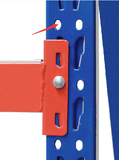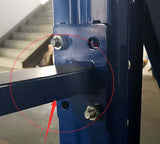Long Span Shelving is Generally Stable
Falcon’s longspan shelving is generally quite stable, if the floor is flat and even and the loads on the shelves are not too heavy. However, if the floors are uneven or you need to load up the shelves with heavier items you may need to fasten your shelving to the floor. Fastening is also recommended for high traffic areas or where you need steps or mechanical aids to reach items at higher levels. There are a two main ways to achieve additional security:
- Fastening the shelving to the floor
- Fastening the shelving to the wall
Set out below is a brief outline of each method.
Ways to Secure Longspan Shelving
1. Fastening the Shelving to the Floor
Our longspan shelving units come with footplates that have predrilled holes in them. So it's easy to fasten the units to the floor. The holes are 12mm in diameter (see image below).
For concrete floors, the predrilled holes will take Dynabolts to fasten the unit to the floor.
Floor Levelling Plates
If the floor is uneven, then we recommend the use of floor levelling plates (shims) to adjust the shelving until it is horizontal. Falcon’s floor levelling plates are 1.5mm thick and are designed to fit between the footplate of a longspan unit and the floor (see image below). The plates are stackable, if a larger adjustment is required.
2. Fastening the Shelving to the Wall
If it isn't practical to drill into the floor, then it is possible to fasten Falcon’s longspan shelving to the wall. Using this method, the unit should remain standing with its footplates on the floor.
Direct attachment to the Wall
Use screw-in anchors or screw bolts going through the locking pin holes in the sides of the longspan uprights (see image below) to fasten the unit directly against a wall. For example, you could use a 6mm AnkaScrew to fasten the uprights to a masonry wall.
Tip - for maximum strength, drill an undersize hole and then redrill it to the correct size to minimise drill wobble. For a tight fit, screw the bolt in about halfway, then back it out before screwing it down tight.
Offset attachment to the Wall
If it's not practical to position the units directly against the wall, then it's possbile to use "rods" to offset the units from the wall. The image below shows one end of an "offset rod" bolted to an upright. The other end is then bolted to the wall.
Summation
Longspan shelving is generally stable on a flat even floor. However, it is sometimes necessary to fasten the shelving to the floor or the wall for added safety and security. The above blog describes the main ways to secure longspan shelving.



